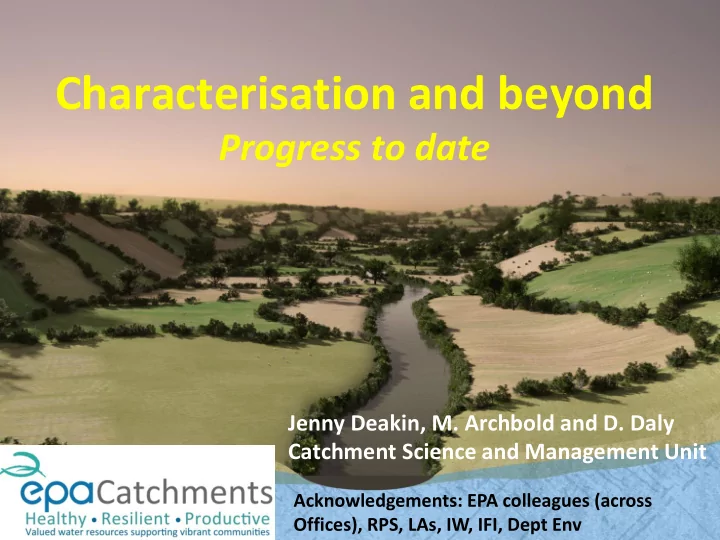

Characterisation and beyond Progress to date Jenny Deakin, M. Archbold and D. Daly Catchment Science and Management Unit Acknowledgements: EPA colleagues (across Offices), RPS, LAs, IW, IFI, Dept Env
Some WFD Implementation Principles 1. Integrated Catchment Management (ICM) approach as the framework 2. “Risk” is ‘ risk of not meeting WFD objectives ’ unless appropriate measures are taken 3. Risk drives action = €€€ . Needs confidence. Therefore, assessment of problems and identification of solutions must be evidence-based 4. Characterisation is used to assess the risk, using a 3-tiered approach, thereby providing the basis for prioritising and targeting measures and informing the monitoring programme.
Characterisation Approach Three TIERS of risk characterisation so that the level of assessment is commensurate with the risk posed Increasing 1: Preliminary risk screening • Cost • Resources 2: Initial characterisation • Detail 3: Further characterisation • Confidence
Water management unit scales 1 National River Basin 4933 Water 583 District 46 Catchments bodies Subcatchments 2 International RBDs Prioritise Plan Monitor Assess measures Report to EU Report status risk
Summary of the approach ‘The right measure in the right place’ Basic measures still apply
The River Suir Catchment Story The Suir story as an example as an example Photo: E. Quinlan
Risk No. of SW bodies Not at 73 (40%) Risk Arglo_020 Good, but deteriorating trend Review 44 (24%) At Risk 64 (35%) Nier_020 High status, now Good
• 4 small GWBs • Landfill and industrial sites • Currently under review
Significant issues (and possible pressures) Issues Possible pressures P – eutrophication Agriculture, WWTPs, DWWTSs, Urban areas, Forestry, Industry Ammonium Peat extraction, WWTPs Fine sediment Channel maintenance, forestry, agriculture Channel modification Channel maintenance, drainage works Industrial pollutants Landfills, industry But we need the significant pressures for each water body
Determining significance 1. Desk based assessment using the S-P-R model 2. Application of new nutrient modelling tools Source Load Apportionment Model Load reduction calculations Pollution Impact Potential Maps for diffuse agriculture 3. Local knowledge from EPA colleagues 4. Workshops and discussions with LAs (and IFI in later catchments), incorporating their data and knowledge More than one pressure may be significant Investigative assessments are the link to bring sector level significance down to site/field significance
S ource L oad A pportionment M odel WWTPs Industry DWWTs Pasture Arable Forestry Peat Urban runoff Atmospheric
WB load reductions needed Additional reductions may also be needed following further investigations Total known reductions for improving rivers and lakes is sufficient for improving TraCs
Pollution Impact Potential (PIP) for Phosphate to Surface Water Arising from Diffuse Agricultural Sources Map of Relative Risk Not for field- scale assessment (1:20,000) Helps focus investigative assessments & inspections
Significant pressures in the Suir
15
2 WWTPs >500pe 3 Smaller plants
1 IPPC, 5 S4s
3 towns covering 7 WBs
10 WBS
2 main rivers (Fishmoyne and Farneybridge)
WFD Environmental Objectives as context for consideration of measures Prevent deterioration in status. Aim to restore to good status by 2015. Comply with the standards and objectives for Protected Areas. Alternative objectives may be set, such as: An extended deadline, e.g., good status by 2021 or 2027. A less stringent objective, e.g., achieving good status after 2027.
Priorities to inform Objectives and measures Priority 1: (a) High status sites (b) Protected areas (Drinking water, SACs, etc) (c) No deterioration (reverse trends) Priority 2: (a) Improvements in a feasible number of subcatchments (multi-disciplinary projects) (b) Complete all Investigative assessments Priority 3: (a) Protect sites that are not currently At Risk (Basic measures adequate) (b) Restore all sites that are not at Good Status
Management strategies for achieving objectives 1. Local (site/field) mitigation measures (e.g. buffer zones) 2. Engagement & knowledge exchange (catchment water officers and farm advisors crucial) 3. Incentives (e.g. Glas, RDP, Septic tanks, etc, locally led) 4. Innovation and new technology 5. Integration into the planning process 6. Licensing of discharges (& abstractions eventually) 7. Compliance checking & enforcement
Proposed Suir measures One WWTP upgrade (+ 6 others post-2021) Consider improvements at 3 small WWTPs (CoAs) Investigate & mitigate pesticide issues at one supply Investigative assessments (IAs) in 20 priority WBs WB specific measures as determined through the IAs for agriculture, forestry, industrial, diffuse urban and DWWTS pressures 2 substantial multi-disciplinary, multi-agency projects (Clashawley and Ara subcatchments) Work plans in place for remediating point sources impacting on groundwater
Target improvements 2021 If measures are 90 implemented and 80 70 No. rivers and lakes are successful, we 60 are aiming to 50 40 achieve: 30 2010-12 20 2021 • 10 20 WBs improved to 0 Good or High status. High Good Bad Moderate Poor Objectives not met • 2 WBs improved but remain <Good • Protected Area objectives achieved All data, assessments, objectives (incl tracking of progress towards measures) are being recorded in detail in the WFD Application, and summarised in catchment assessments
Next steps 1. Complete the remaining subcatchments (end Oct) 2. Progress the catchment assessments 3. Further development of the WFD Application 4. Contribute to the draft RBMP 5. Review, update and finalise in 2017 6. More engagement in 2017, particularly in relation to the catchment assessments
Recommend
More recommend